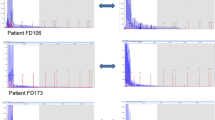Abstract
Purpose
To evaluate the association of single nucleotide polymorphisms (SNPs) and the intronic expansion of a trinucleotide repeat (TNR) in the TCF4 gene with Fuchs endothelial corneal dystrophy (FECD) in a Thai population.
Methods
In total, 54 Thai FECD patients and 54 controls were recruited for the study. Five SNPs (rs613872, rs2123392, rs17089887, rs1452787, and rs1348047), previously reported to be associated with FECD, were genotyped by direct sequencing. The repeat length was determined by direct sequencing of PCR-amplified DNA (a short tandem repeat; STR assay) and by triplet repeat primed PCR (TP-PCR).
Results
Only one of the 54 patients with FECD harboured rs613872 (1.9%). Four SNPs (rs2123392, rs17089887, rs1452787, and rs1348047), which are not rare polymorphisms in the Thai population, were found in approximately half of the patients. Of the 54 patients, 21 (1 homozygous and 20 heterozygous patients; 39%) harboured a TNR ≥ 40, while 33 patients (61%) harboured a TNR < 40.
Conclusions
The association of TNR expansion in TCF4 with FECD is shown for the first time in the Thai population. The intronic TNR expansion identified in various ethnic groups underlines the importance of expansion as a potent pathophysiological cause of FECD.
Similar content being viewed by others
Introduction
Fuchs endothelial corneal dystrophy (FECD) is a bilateral corneal disease characterised by a progressive loss of corneal endothelial cells that typically begins after the age of 40 [1, 2]. The corneal endothelium is responsible for maintaining corneal transparency by regulating the amount of water in the corneal stroma; therefore, a severe loss of corneal endothelial cells results in vision loss due to corneal haziness.
FECD initially showed an autosomal dominant inheritance pattern with variable penetrance and expressivity in investigations of large families conducted in the 1970s and 1980s [3,4,5]. Early screening studies for functional candidate genes and investigations of causal genes of other corneal endothelial dystrophies identified four genes (SLCA411, TCF8, LOXHD1, and AGBL1) that were associated with late-onset FECD (the typical form of FECD) [6,7,8,9,10,11]. However, these genes were not frequently encountered in the general population of FECD patients; therefore, researchers have continued searching for a more common genetic cause.
In 2010, a genome-wide association study (GWAS) reported a significant association between the intronic single nucleotide polymorphism (SNP) in the transcription factor 4 (TCF4) and late-onset FECD [12]. Subsequently, Wieben et al. reported a strong association between FECD and a cytosine–thymine–guanine (CTG) repeat expansion in the non-coding region of TCF4 and found a sensitivity and specificity of ≥50 repeats of 79% and 96%, respectively, for identifying FECD patients in their cohort [13]. Subsequent studies have replicated these novel findings in various populations, although the frequency of the repeat expansion in FECD tends to be lower in non-Caucasian (i.e., Chinese, Indian, and Japanese) cohorts [Full size table
Direct sequencing and TP-PCR demonstrated that no control subjects harboured a CTG trinucleotide repeat (TNR) higher than 40 repeats. Conversely, 21 of the 54 patients (39%; 1 homozygous and 20 heterozygous) harboured CTG TNR lengths greater than 40, while 33 patients of the 54 patients (61%) did not harbour TNR lengths greater than 40 (P < 0.001). The mean age of the 5 male and 16 female patients harbouring ≥40 CTG TNR was 65.3 ± 9.6 years (range, 39–78 years), while the mean age of the 5 male and 28 female patients harbouring <40 CTG TNR was 61.1 ± 15.6 years (range, 21–85 years). No statistically significant difference was observed in either age or gender among control subjects, patients with or without CTG TNR expansion higher than 40 repeats (Table 2). In agreement with the previous study, the distribution of the TNR length was bimodal, and fourteen patients harboured ≥100 CTG TNR (Fig. 1). One patient with FECD (a 66-year-old female) was homozygous for the CTG TNR expansion, and she was considered to be a Krachmer grade 2 and exhibited a transparent cornea. Clinical manifestations of the representative Thai patients with FECD harbouring CTG TNR < 40 and ≥40 are shown in Supplementary Fig. 1.
Frequency histogram of the cytosine–thymine–guanine (CTG) repeat length. The CTG trinucleotide repeat (TNR) length of the longest allele determined by direct sequencing and triplet repeat primed PCR (TP-PCR) in 54 subjects with Fuchs endothelial corneal dystrophy (FECD) and 54 non-FECD Thai controls is shown as a histogram. The distribution of TNR length in FECD cases was bimodal, and 14 patients harboured ≥100 CTG repeats





